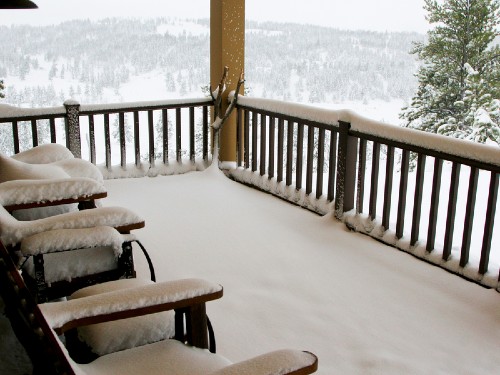On some winter days, nothing can feel nicer than grabbing a warm cup of coffee or tea and appreciating the natural beauty of your snow-covered backyard, whether alone or with family and friends. Eventually, though, you'll need to clear the snow off your deck.
Finding the right ice melt for wood decks and composite decking is crucial. After spending time and money on creating the perfect space, the last thing DIY deck builders and deck owners want to do is damage the wood deck framing, natural or composite deck boards, and deck hardware with the wrong de-icer or chemicals!
Identifying the Best Ice Melt for Wood Decks and Composite Decking
Selecting the wrong ice melt for wood decks can significantly reduce the life of the wood and fasteners in the deck. Read through the details of the de-icer options below to find the perfect one for your home, yard, and surrounding vegetation.
Sodium Chloride (AKA Rock Salt)
Sodium chloride is inexpensive and helps keep moisture from accumulating on roads and walkways, but it is not an effective de-icer at low temperatures (It's only good down to 15°F). It also damages concrete, poisons the soil, and can kill plants and harm pets.
Rock salt can be a solid option if you're living in a pet-free home without any surrounding plants or vegetation. If that's the case and you live in a climate where the lowest winter temperatures hover around 10° to 15° F, - selecting sodium chloride would be a great choice for your decking and budget.
Calcium Chloride
If you're looking for the best ice melt for wood decks and composite decking, calcium chloride is the most frequently recommended ice-removing agent from top composite decking manufacturers!
Calcium chloride works at very low temperatures and isn't quite as damaging to the soil and vegetation as sodium chloride. But it costs a bit more and may harm any concrete or masonry in the deck footings or pathways. Calcium chloride develops more moisture than other de-icing agents, meaning that calcium chloride won't keep surfaces dry but rather slushy.
On the other hand, prolonging a wet decking surface can be a good thing as calcium chloride releases heat when reacting with water, so it can melt snow and ice on contact.
Potassium Chloride
Potassium chloride doesn't work at extremely low temperatures and may cost a little more than sodium chloride, but it is relatively kind to vegetation and concrete. The lowest working temperature for this de-icing agent is 24° F, making for a poor choice as an ice melt for wood decks and composite decking in a lot of northern and western winter climates.
CMA (AKA Calcium Magnesium Acetate)
CMA is easily one of the safest chemical de-icers to use for outdoor areas with concrete and plants. It does, however, only work in temperatures as low as 15° F.
Calcium magnesium acetate is better at preventing water from re-freezing than at melting snow and ice. CMA tends to leave a slush, which may be undesirable for sidewalks or driveways.
Calcium magnesium acetate can also act as a preservative for natural wood as it neutralizes acids and it prevents rust and other corrosion by mellowing the salt’s natural corrosive properties.
Household Products That Work As an Ice Melt for Wood Decks and Composite Decking
Don't get caught out in the cold — many common household products can be used as de-icing agents! Basically, any product that contains salt or sugar will work. Examples include liquid from a pickle jar, sugary soft drinks, or a homemade solution of salt or sugar in water.
What NOT To Use on a Wood Or Composite Deck
While ice melt for wood decks and composite decking is helpful, there are some things that should never be used on composite or wood decks:
- Metal ice shovels
- Metal or plastic ice chippers
- De-icers with dye or colorant
What To Use on an Icy Deck
If you want to remove snow and ice from your deck, here are some options that work well:
- Ice melting mats
- Calcium chloride-based de-icer
- Household or shop broom
- Pickle juice

How To Use Ice Melt for Wood Decks and Composite Decking
Once you've selected the best ice melt for your wood deck or composite decking, follow these simple steps to ensure your deck stays safe and in good condition throughout the winter. By applying ice melt properly, you can effectively prevent slips and maintain your deck’s appearance.
- Clear the Snow: Start by removing as much snow as possible from the deck with a broom. This helps the ice melt work more efficiently and reduces the amount needed.
- Follow the Manufacturer's Instructions: Read the label and follow the manufacturer’s instructions for application rates and specific precautions.
- Apply Evenly: Spread the ice melt evenly across the deck surface. Consider using a hand-held spreader for more even distribution.
- Allow Time to Work: Let the ice melt sit for the recommended time. This will help it break down the ice more effectively.
- Remove Slush: Once the ice begins to melt and turns to slush, clear it away with your broom or a plastic shovel. This prevents refreezing and further maintains safety.
Frequently Asked Questions About Ice Melt for Wood Decks and Composite Decking
The $4 billion global ice melt market can be confusing, but DecksDirect is here with the information you need about ice melt for wood decks and composite decking. The following are some common questions we receive.
Is ice melt safe for wood decks and pets?
Many ice melts are formulated to be safe for wood decks and pets, but it’s essential to choose the right one. Look for products labeled as safe for wooden surfaces and pet-friendly to ensure minimal impact on the deck and avoid harm to animals.
Can I use ice melt on composite decking?
Yes, you can use ice melt on composite decking, but it’s best to select a product that's specifically designed for use on composite materials. Always avoid rock salt, as it can cause surface damage. Top composite decking manufacturers frequently recommend calcium chloride.
Can ice melt damage my deck?
If used improperly or in excessive amounts, certain ice melts can damage your deck. Selecting the correct, deck-safe product and following proper application methods will help minimize the risk of damage.


